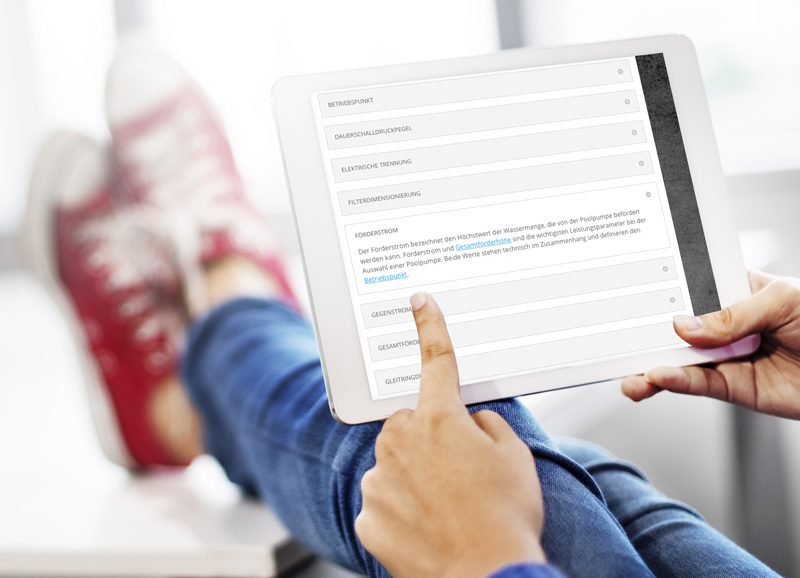A private swimming pool is not rocket science. Know-how is all it comes down to. There are even a few simple rules and useful tips for the technical maintenance and care. Should you have any further questions, the Aqua TechniX team is happy to help.
blank
What is a self-priming pump?
A self-priming pump has the ability to handle the air and gas content within pool water in the suction line, as it is able to aerate the suction line independently. Therefore it is possible to position self-priming pumps above the water level (max. 3 m). However the pump must be filled to the suction inlet with water before initial start-up.
What is the maximum suction height?
Theoretically the maximum suction height of a pump is approx. 10 m, however technically, and for various reasons, it only reaches 7 m or 8 m. For a pool pump’s area of application you also have to factor in the specific parameters of the unit e.g. pump construction and performance, unit dimensions, frictional loss in the connection lines, water load due to coarse and fine dirt particles etc. Thus realistically speaking you can plan with a reliable suction height of 3 m.
Why must self-priming pumps first be filled with water?
A self-priming pool pump can only function when it has water in the mechanism. Only then can it build up suction power and transport air content in the suction line. Therefore the pump housing must be filled to the suction inlet with water. Running dry would damage the mechanical seal.
What are the maintenance requirements of AQUA TECHNIX pumps?
Aqua TechniX pumps are generally very low-maintenance. In order to guarantee a constant flow rate and sufficient filtering of the pool water, the strainer basket must simply be cleaned at regular intervals. We would recommend visual inspections on a weekly basis at the least.
How should I best store my pump over the winter season?
Pool pumps carry water and must therefore be placed into winter storage in good time. To do so please drain the pump completely. It’s best to store it dry and covered with a towel to protect it from dust over the winter.
What should I be aware of before restarting my pump in the spring?
If the pool machine has been out of operation for a longer period of time (e.g. during the winter season), the motor may have become stuck. You should therefore perform the “screwdriver check” BEFORE turning the pump on to see if the pump still works smoothly. To do so, insert a screwdriver (or something similar) through the ventilation grille on the outside of the motor and into the slot on the motor shaft and turn it slightly to the right. If you don’t feel any resistance then everything is ok, if there was any resistance this action will have loosened the blockage. You can now turn the pump on again. If the pump remains stiff or it makes unusual noises, have it examined by a trained pump professional.
Why are wear parts not covered under warranty?
Wear parts are not covered under warranty, as mechanical wear during use is unavoidable – just like rubber abrasion on car tyres. At Aqua TechniX wear parts are all sealing and rotating construction elements of the pump: the mechanical seal, O-rings, flat seals, the impeller and the ball bearings in the motor shaft.
What causes a mechanical seal to break?
Possible causes are the pump running dry, dirt or simply wear – a mechanical seal consists of wear parts. A few drops of water may escape from time to time, above all during the running-in period. However if this persists, the mechanical seal is broken and must be replaced.
What causes ball bearings to break?
Possible causes and intervention:
- A leaky mechanical seal could cause water to penetrate the ball bearings and damage them > eliminate the leak immediately!
- There may be too high a humidity at the pump’s installation site > provide sufficient ventilation.
- Motor overload or overheating could reduce the service life of the ball bearings > check the motor protection switch.
- The ball bearing’s service life has reached an end > install spare parts.
What causes a motor to overload?
Possible causes:
- Over/under voltage or damage to the winding > a motor protection switch set to the rated current is required to monitor this.
- Stiff pump e.g. due to sand in the slip ring, foreign bodies in the impeller or stiff/worn ball bearings.
- Incorrect connection at the motor’s terminal board e.g. incorrect assignment of Y/D to the voltage supply.
What causes the motor to hum?
Possible causes:
- The pump is blocked e.g. due to sand in the slip ring or foreign bodies in the impeller.
- The capacitor in a single phase motor is damaged.
- The winding in a three-phase motor is damaged or a phase/fuse is faulty.
What should I be aware of when replacing the motor unit?
- Pay attention to the correct direction of rotation when inserting a new three-phase motor. This is shown with an arrow e.g. on the fan. If you operate the motor in the wrong direction of rotation, the pump will no longer reach the required circulation performance and the pump hydraulics may be damaged.
- The value set on the motor protection switch must correspond to the pump’s rated current. Compare the specifications on the name plate and if necessary correct the settings on the motor protection switch.
- Before restarting the pump, check it for leaks.
